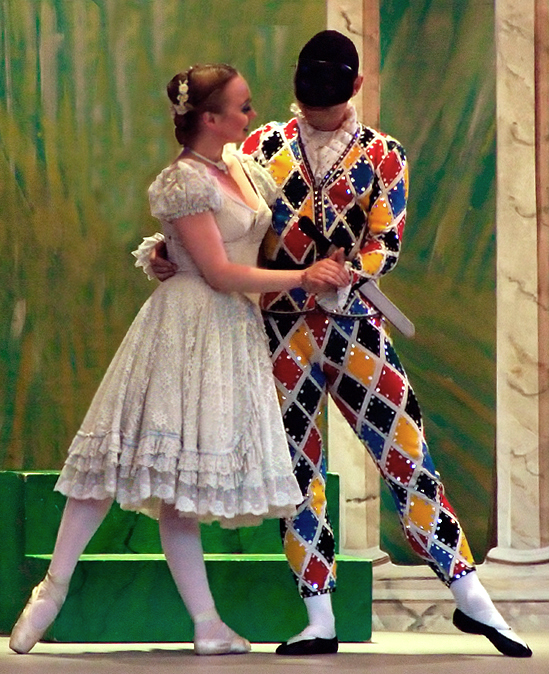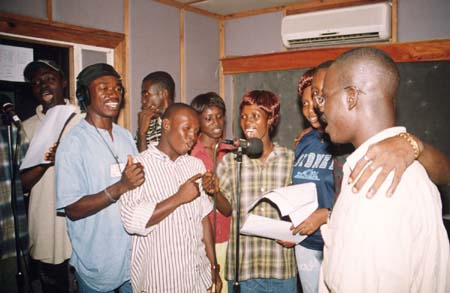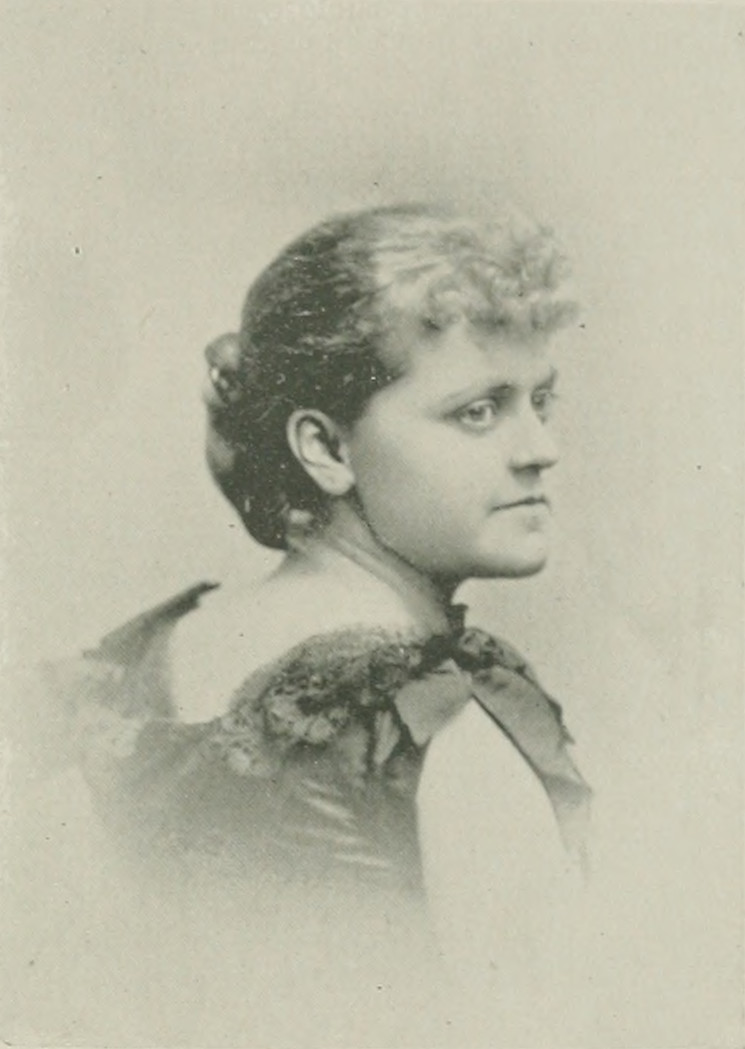|
Stage Reading
A stage reading, also known as a staged reading, is a form of theatre without sets or full costumes. The actors, who read from scripts, may be seated, stand in fixed positions, or incorporate minimal stage movement. There is an overlap with the term play reading, One US source says that play reading incorporates little or no movement, while the latter is performed, with actions, on a stage. Description A stage reading of a new play in development is an intermediate phase between a cold reading, with the cast usually sitting around a table, and a full production. A narrator may read stage directions aloud. The purpose is to gauge the effectiveness of the dialogue, pacing and flow, and other dramatic elements that the playwright or director may wish to adjust. Audience feedback contributes to the process. In play-development workshopping, the stage reading is one of the forms of workshop, along with the rehearsed reading, the exploratory workshop, and the full workshop producti ... [...More Info...] [...Related Items...] OR: [Wikipedia] [Google] [Baidu] |
Theatre
Theatre or theater is a collaborative form of performing art that uses live performers, usually actors or actresses, to present the experience of a real or imagined event before a live audience in a specific place, often a stage. The performers may communicate this experience to the audience through combinations of gesture, speech, song, music, and dance. Elements of art, such as painted scenery and stagecraft such as lighting are used to enhance the physicality, presence and immediacy of the experience. The specific place of the performance is also named by the word "theatre" as derived from the Ancient Greek θέατρον (théatron, "a place for viewing"), itself from θεάομαι (theáomai, "to see", "to watch", "to observe"). Modern Western theatre comes, in large measure, from the theatre of ancient Greece, from which it borrows technical terminology, classification into genres, and many of its themes, stock characters, and plot elements. Theatre artist Patrice ... [...More Info...] [...Related Items...] OR: [Wikipedia] [Google] [Baidu] |
Theatrical Scenery
Theatrical scenery is that which is used as a setting for a theatrical production. Scenery may be just about anything, from a single chair to an elaborately re-created street, no matter how large or how small, whether the item was custom-made or is the genuine item, appropriated for theatrical use. History The history of theatrical scenery is as old as the theatre itself, and just as obtuse and tradition bound. What we tend to think of as 'traditional scenery', i.e. two-dimensional canvas-covered 'flats' painted to resemble a three-dimensional surface or vista, is a relatively recent innovation and a significant departure from the more ancient forms of theatrical expression, which tended to rely less on the actual representation of space senerial and more on the conveyance of action and mood. By the Shakespearean era, the occasional painted backdrop or theatrical prop was in evidence, but the show itself was written so as not to rely on such items to convey itself to the audience. ... [...More Info...] [...Related Items...] OR: [Wikipedia] [Google] [Baidu] |
Stage Clothes
Stage clothes is a term for any clothes used by performers on stage. The term is sometimes used only for those clothes which are specially made for the stage performance by a costume designer or picked out by a costume coordinator. Theatrical costumes can help actors portray characters' age, gender role, profession, social class, personality, and even information about the historical period/era, geographic location, time of day, as well as the season or weather of the theatrical performance. Stage clothes may be used to portray a historical look or they can be used to exaggerate some aspect of a character. Description Any clothing used by performers (singers, actors, or dancers) on stage may be referred to as stage clothes. More specifically, the term is sometimes used only for those clothes which are specially made for the stage performance by a costume designer or picked out by a costume coordinator. However, many performers also pick up regular clothes and make them thei ... [...More Info...] [...Related Items...] OR: [Wikipedia] [Google] [Baidu] |
Blocking (stage)
In theatre, blocking is the precise staging of actors to facilitate the performance of a play, ballet, film or opera. Historically, the expectations of staging/blocking have changed substantially over time in Western theater. Prior to the movements toward "realism" that occurred in the 19th century, most staging used a "tableau" approach, in which a stage picture was established whenever characters entered or left the stage, ensuring that leading performers were always shown to their best advantage. In more recent times, while nothing has changed about showing leading performers to their best advantage, there have been changing cultural expectations that have made blocking/staging more complicated. There are also artistic reasons why blocking can be crucial. Through careful use of positioning on the stage, a director or performer can establish or change the significance of a scene. Different artistic principles can inform blocking, including minimalism and naturalism. Etymology Bo ... [...More Info...] [...Related Items...] OR: [Wikipedia] [Google] [Baidu] |
Collins English Dictionary
The ''Collins English Dictionary'' is a printed and online dictionary of English. It is published by HarperCollins in Glasgow. The edition of the dictionary in 1979 with Patrick Hanks as editor and Laurence Urdang as editorial director, was the first British English dictionary to be typeset from the output from a computer database in a specified format. This meant that every aspect of an entry was handled by a different editor using different forms or templates. Once all the entries for an entry had been assembled, they were passed on to be keyed into the slowly assembled dictionary database which was completed for the typesetting of the first edition. In a later edition, they increasingly used the Bank of English established by John Sinclair at COBUILD to provide typical citations rather than examples composed by the lexicographer. Editions The current edition is the 13th edition, which was published in November 2018. The previous edition was the 12th edition, which was pu ... [...More Info...] [...Related Items...] OR: [Wikipedia] [Google] [Baidu] |
Actors' Equity Association
The Actors' Equity Association (AEA), commonly referred to as Actors' Equity or simply Equity, is an American labor union representing those who work in live theatrical performance. Performers appearing in live stage productions without a book or through-storyline (vaudeville, cabarets, circuses) may be represented by the American Guild of Variety Artists (AGVA). The AEA works to negotiate and provide performers and stage managers quality living conditions, livable wages, and benefits. A theater or production that is not produced and performed by personnel who are members of the AEA may be known as "non-Equity". Background Leading up to the Actors' and Producers' strike of 1929, Hollywood and California in general, had a series of workers' equality battles that directly influenced the film industry. The films ''The Passaic Textile Strike'' (1926), ''The Miners' Strike'' (1928) and ''The Gastonia Textile Strike'' (1929), gave audience and producers insight into the effect and ... [...More Info...] [...Related Items...] OR: [Wikipedia] [Google] [Baidu] |
Radio Play
Radio drama (or audio drama, audio play, radio play, radio theatre, or audio theatre) is a dramatized, purely acoustic performance. With no visual component, radio drama depends on dialogue, music and sound effects to help the listener imagine the characters and story: "It is auditory in the physical dimension but equally powerful as a visual force in the psychological dimension." Radio drama includes plays specifically written for radio, docudrama, dramatized works of fiction, as well as plays originally written for the theatre, including musical theatre, and opera. Radio drama achieved widespread popularity within a decade of its initial development in the 1920s. By the 1940s, it was a leading international popular entertainment. With the advent of television in the 1950s radio drama began losing its audience. However, it remains popular in much of the world. Recordings of OTR (old-time radio) survive today in the audio archives of collectors, libraries and museums, as well a ... [...More Info...] [...Related Items...] OR: [Wikipedia] [Google] [Baidu] |
Voice Acting
Voice acting is the art of performing voice-overs to present a character or provide information to an audience. Performers are called voice actors/actresses, voice artists, dubbing artists, voice talent, voice-over artists, or voice-over talent. Voice acting is recognised as a specialized dramatic profession in the United Kingdom, primarily due to BBC broadcasts of radio drama production. Examples of voice work include animated, off-stage, off-screen or non-visible characters in various works such as feature films, dubbed foreign-language films, animated films, anime, television shows, video games, cartoons, documentaries, commercials, audiobooks, radio dramas and comedies, amusement rides, theater productions, puppet shows and audio games. Voice actors are also heard through pre-recorded and automated announcements that are a part of everyday modern life in areas such as shops, elevators, waiting rooms and public transport. The role of a voice actor may involve singing, most ... [...More Info...] [...Related Items...] OR: [Wikipedia] [Google] [Baidu] |
Florence Fowle Adams
Florence Adelaide Fowle Adams (October 15, 1863 – July 31, 1916) was an American dramatic reader, actor, author, and teacher. Biography She was born Florence Adelaide Fowle in Chelsea, Massachusetts, the only child of the artist Edward Augustus Fowle. She attended the Chelsea public school, the Girls' Latin School in Boston, and the Boston School of Oratory, from which she graduated in 1884. Fowle joined the faculty of the Boston School of Oratory, where she taught the Delsarte method of dramatic expression developed by the teacher François Delsarte. Feeling the lack of a textbook for beginning students that clearly set forth the principles of the Delsarte method, she published her own book on the Delsarte method, ''Gestures and Pantomimic Action'' (1891), using herself as the model for the volume's many illustrations. She occasionally appeared on stage in dramatic roles; for example, as Julie de Mortemar in Edward Bulwer-Lytton's play '' Richelieu''. She also organized her ... [...More Info...] [...Related Items...] OR: [Wikipedia] [Google] [Baidu] |
Helen Louise Babcock
Helen Louise B. Babcock (August 13, 1867-July 5, 1955) was an American educator, elocutionist, and dramatic reader. Early years and education Helen Louise Bailey was born in Galva, Illinois. August 13, 1867. She early displayed a marked talent for elocution and on reaching woman's estate she decided to make dramatic reading her profession. With that aim she became a pupil in the Cumnock School of Oratory of the Northwestern University, and, being an earnest student, she was graduated with the highest honors. Career Afterwards, she became an assistant instructor in the same oratorical school, and was very successful in the work of developing elocutionary and dramatic talents in others. Perfectly familiar with the work, she was able to guide students rapidly over the rough places. After severing her connection with the Cumnock school, she taught for a time in Mount Vernon Seminary and College, Washington, D.C. After the death of her mother, in 1890, she accompanied her father abr ... [...More Info...] [...Related Items...] OR: [Wikipedia] [Google] [Baidu] |
Mabelle Biggart
Mabelle Biggart (February 22, 1861 – ?) was an American educator, dramatic reader, preacher, and writer. In 1890, Biggart was in charge of the department of elocution at the Chautauqua assembly of Glen Park, Colorado, and that she was giving exercises illustrating the Delsarte System. Around the same time, she had been instrumental in starting the Polytechnic Institute and Woman's Athletic Club of Denver, intended to aid women to gain health, strength, and beauty. She had also assumed charge of a "Polytechnic Department" in the ''Denver NewsLetter'', devoting the space to physical culture, science, and literature. She wrote articles for various publications including, "A Woman that is a Woman", "List to the Voice!", "Newfoundland", "Where is the New Woman?", "Dr. Grenfell's Labrador Mission", and "On the Painted Desert". Early life and education Mabelle Biggart was born in New York City, February 22, 1861. She was of Scottish and English ancestry, descending from a long line of t ... [...More Info...] [...Related Items...] OR: [Wikipedia] [Google] [Baidu] |
Table Work
The read-through, table-read, or table work is a stage of film, television, radio, and theatre production when an organized reading around a table of the screenplay or script by the actors with speaking parts is conducted. In addition to the cast members with speaking parts, the read-through is usually attended by the principal financiers or studio executives, producers, heads of department, writers, and directors. It is generally attended only by people involved in the production. It is usually the first time everyone involved in the production will have gathered together and it is traditional for everyone to introduce themselves by both name and job. The director may then open proceedings by making a short speech outlining their aspirations for the project. An additional professional actor not otherwise involved in the production may be hired to read the non-dialogue parts of the script such as scene headings and action. These parts of the script are usually edited down sever ... [...More Info...] [...Related Items...] OR: [Wikipedia] [Google] [Baidu] |








.png)
